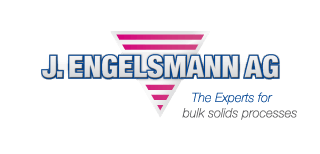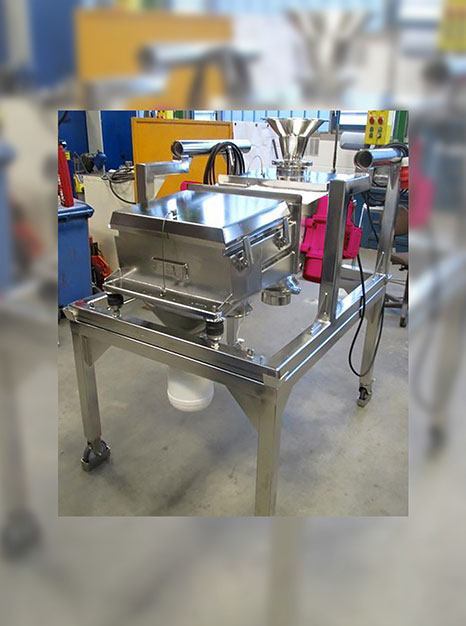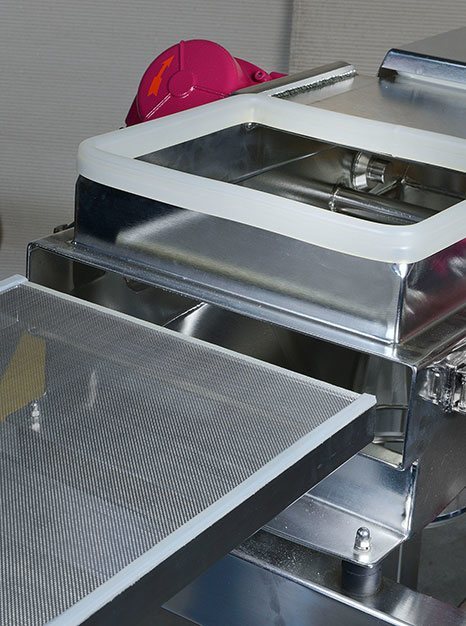- Sectors ›
- Article: Protective screening in pharmaceutical production: Be up to the mark with mobile screening technology
Protective screening in pharmaceutical production: Be up to the mark with mobile screening technology
The regulations for machine solutions when producing pharmaceuticals are extraordinarily high. GMP plays a central role. No matter whether this affects sealed apparatus or machines in stainless steel or facilities carried out in a hygienic design: There are urgent aspects of hygiene which should guarantee the highest possible protection for the users. As well as GMP regulations there are stringent requirements with regards to productivity and cost effectiveness, and operationally specific production conditions which need to be considered. A current project by screening technology specialist J. Engelsmann AG shows how, with machine solutions tailored to operationally specific requirements, productivity and performance capacities can be increased.
When manufacturing pharmaceuticals, aside from a germ free production environment that meets the highest hygiene demands, there is also no room for agglomerates, dust and incorrectly sized particles in the raw material that is to be processed. To ensure the highest level of purity possible of the agents formed into capsules or tablets, a protective screening is carried out before they are processed further. Adjusting the screening technology necessary for this to the existing production conditions as well as how easy the product is to screen all need to be considered when developing a machine solution as the following example of use shows:
A globally active pharmaceutical manufacturer from Japan was looking for an alternative machine solution for its factory in the eastern states of Germany to improve the productivity and cost effectiveness of its protective screening processes. The factory plays an important role in the manufacturer’s global production network, in particular regarding quality because the manufactured products are delivered across the whole world. At the location, mainly solid pharmaceuticals are made for various areas of application.
Only processed further with an upstream protective screening
The products which exist as pellets are small spherical particles ranging from a few micrometers up to several millimeters which fill capsules or are pressed into tablets. They are dry, pourable, but are prone to electrical charge. Before the pellets can be processed, using an upstream protective screening it must be ensured that only the desired particle range ends up being processed further. Unwanted agglomerates, adherent dust particles as well as the particles which are larger than the particle range determined are filtered out. For protective screening, up until then, the buyer had used several circular screening machines which didn’t meet the existing requirements to the full extent in terms of flexibility and cost effectiveness.
In particular product batches it was necessary to filter three fractions (correctly sized particles, oversized particles and undersized particles). The circular screening machines used, however, were only able to separate it into two fractions, correctly sized particles and oversized particles, which meant that there were undersized particles in the correctly sized particles which had to be separated with a second screening.
Another problem lay in the complex way for changing the sieve and the inconvenience of cleaning the circular screening machine. For this the machines had to be disassembled and the sieve insert had to be removed from above which caused long periods of machine downtime. Since, however, after every screening process, the entire machine and sieve was cleaned and during batch changes the sieve insert was changed, the downtime related to this was an important productivity and capacity factor which provided a considerable need to optimization.
Because of the prevalent difficulties, the pharmaceutical manufacturer turned to the screening technology manufacturer Engelsmann to find an alternative machine solution to improve the screening capacity. After a few joint test trials, the Engelsmann constructors suggested using a vibration screening machine from the range JEL Konti as a solution to the problems. The JEL Konti was developed by Engelsmann for continual protective or grading screening in production and in labs. Suitable for dry and fluid bulk solids, the fact that the machine is easy to handle makes a highly specific screening capacity possible. Thanks to its compact structure and low height, the Konti vibration screening machine can be flexibly integrated into the existing production facilities. Thanks to the front-ended extractable sieve insert it is possible to change the sieve in the JEL Konti quickly.
The lifting column brings the screening machine into position
The next step consists in adjusting the machine type to the general pharmacological directives as well as to the manufacturer’s operationally specific production requirements. To carry out the protective screening, the pharmaceutical manufacturer uses the lifting column which lifts up the container filled with pellets and lifts it to approx. 2.50 meters high. The lifting columns are furnished with two other spindles for lifting the screening machine. When the screening machine is on the lifting column, it is raised and positioned underneath the container. Then an empty container underneath the correctly sized particle outflow is placed on the floor with two other empty plastic vats attached to the oversized and undersized particle outflow supports. After the screening process the screened incorrectly sized particles in the container are put back into the original manufacturing process. The container with the correctly sized particles is taken with a lifting cart to the next processing facility where the pellets are pressed into tablets or put into capsules. After the screening process, the screening machine is taken off the lifting column and taken to the cleaning station.
The base frame of the 300kg and 60cm tall JEL Konti was fitted with two round pipes which latch on to the spindles in order to be able to be lifted by the lifting column already there. The product inlet is designed so that it plunges into the container with the pellets. The machine was fitted with a removable feed funnel and exchangeable adapters for regulating capacity at the buyer’s request. With the adapters’ various diameters, the pellets can be controlled as they are fed in, as to ensure a continual and seamless product flow which means that the machine will not be overfilled.
By opening the hand flap on the container with the pellets, the machine is loaded and by turning on the screening machine the process is started. Through the connection between the vibration motor and the lifting column control using a plug connection, the screening machine can be operated with ease. The screening process of the protective screening machine is continual and suitable for two or three fractions. The screen mesh agitated by the two vibration motors with a capacity of 2 x 0.30kW and a revolution speed of 1,500rpm makes a precise screening process with a filtration degree of 98.5-99% possible. The direction of the vibration is altered by positioning the vibrators. For an effective protective screening, the Konti has two sieve inserts on top of each other, each 0.45sqm in area, the gaps in the mesh on the upper sieve are wider than on the lower sieve. If necessary, the machine can be set up to screen two fractions by using a blank panel. According to the product specifications there are a total of 19 sieve inserts with various mesh widths. In product batches which tend to clog the mesh, a triangle screen cleaning system can be fixed to the insert if necessary. The filtered oversized particles or dust are channeled out of the machine into the incorrectly sized particle container through an inbuilt oversized particle outflow. To monitor the screening process, the JEL Konti is fitted with a lid which can be removed during the process without dismantling the machine.
Using the mobile machine in GMP design
To be able to use the machine with several lifting columns in different locations and to be able to move it to the cleaning station after the screening process, the JEL Konti can be delivered with a mobile base frame. The chassis as well as the machine is earthed due to the product becoming electrically charged. The Engelsmann vibration screening machine is fitted with quick change equipment for cleaning the machine, it means that the sieves can be changed within 30 seconds. Quick release catches are used which are quick to open and without separation of feeding the product in and taking it out, make it possible to quickly access the front facing removable sieve inlets. The protective screening machine is stainless steel as per GMP directives for use in pharmaceutical manufacturing and is suitable for ATEX as it is employed in explosive areas. The mateable FDA seals are easy to remove and clean just like the internally (Ra 0.8µm) and externally smoothed and electrolytically polished surfaces (Ra 1.6µm). In the interior, the rounded corners prevent there being any dead pace where product residue could collect.
In live operation, the CE marked Engelsmann screening machine confirmed the trial results: In comparison to the circular screening machine used in parallel, the buyer not only achieved a higher filtration degree combined with a higher throughput capacity, thanks to it being easier to clean and change the sieves, there was also a considerably shorter machine downtime.
Engelsmann provides its vibration machine JEL Konti in 12 different sieve surface sizes from 0.18 to 4.6sqm. A wide range of additional equipment is available for all designs. The single or double-decker JEL Konti can be combined with a stationary or mobile base frame. Integrated cleaning options for the screening mesh include an ultrasound, ball or triangle cleaning system. Additional components such as spray skirts, input and output cuffs or integrated viewing windows enable the machine to be customized to suit individual needs.








